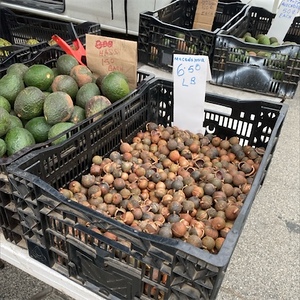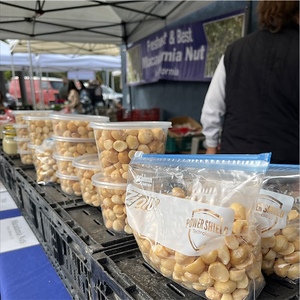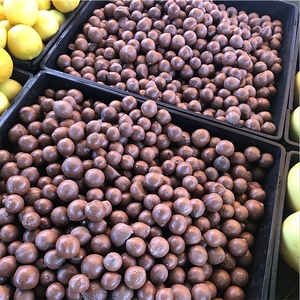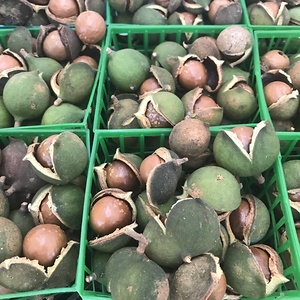


Whole Raw Macadamia Nuts
Estimated Inventory, 5 lbs : 3.05
This item was last sold on : 06/27/25
Description/Taste
Macadamia nuts grow in clusters on a tree in a bright green hull. As the nut ripens, it expands, eventually splitting the hull open and falling to the ground, where they are harvested. In the wild, Macadamia nuts are encased in a very hard, brown husk. This husk is removed in commercial production before it is sold to consumers. Macadamia nuts have a beige to tan hue and feature a puckered seam running through the middle, allowing the nut to be split evenly into two halves. The nuts are also consistently sized, approximately one centimeter in diameter, and have a bulbous, circular appearance with one flat side. Macadamia nuts are smooth, dense, and crunchy with a creamy texture, and when consumed raw, they have a rich and buttery flavor combined with a subtle sweetness and tropical nuances of coconut and honey.
Seasons/Availability
Macadamia nuts are available year-round, with fresh nuts harvested from July to March.
Current Facts
Macadamia nuts are the fruit of the tropical Macadamia tree belonging to the Proteaceae family. There are ten species of Macadamia nut trees found in the wild, but only two varieties are grown for commercial purposes: Macadamia integrefolia, which produces nuts with smooth shells, and Macadamia tetraphylla, nuts with rough shells. In Australia, their place of origin, the nuts are also known as Queensland nuts, Maroochi nuts, and Bush nuts. A typical Macadamia nut tree will take seven years to produce nuts and over a decade to reach full production. Generally, a single tree will produce over sixty pounds of nuts each year. Once the nuts are harvested from the orchard floor, the husks must be removed within twenty-four hours to prevent spoilage. Once the husks are removed, the nuts are dried out to make shelling easier. Macadamia shells are the hardest to crack, requiring over three hundred pounds per square inch to break. Commercially, the nuts are passed through steel rollers sized to crack the shell without damaging the nut. The nuts are then blown clean and sorted into two grades. Lighter-colored nuts are grade I or fancy and used for retail sales, while the darker-colored nuts are sorted as grade II and used in commercial production where size and color are less important. The complexity of cultivation has led to Macadamia nuts being one of the most expensive foods in the world.
Nutritional Value
Macadamia nuts contain the highest levels of monounsaturated fats of all tree nuts. The nuts are one of the only food sources to contain palmitoleic acid. This monounsaturated fatty acid has been shown to aid in fat metabolism, possibly reducing stored fat within the body. Macadamias also have incredibly high levels of omega 3 unsaturated fats, which have been shown to help reduce the risk of heart disease and high blood pressure as well as helping to reduce cholesterol levels in the body. The nuts are also an excellent source of iron, phosphorus, vitamin B, and calcium.
Applications
The deliciously sweet and rich flavor of Macadamia nuts makes them an ideal ingredient for many different applications. The tropical nut is often roasted, salted, and enjoyed straight out of hand. They are also commonly covered in various types of chocolate and sold as candies. The nuts can be ground into a meal and used in pie crust, cakes, cookies, and muffins, pairing well with lemon, coconut, passionfruit, guava, coffee, and other tropical flavors. Recently, the nuts have become popular in alternative dairy products like Macadamia milk and yogurts and are ground into Macadamia nut butter and pressed for oil. Macadamia nuts are also used in savory cooking, especially in Hawaiian cuisine, where the nuts are ground and used to crust Mahi Mahi and shrimp, or roasted and sprinkled over salads featuring mango, pickled onion, and sesame. Macadamia nuts can oxidize quickly when exposed to air, causing them to develop a rancid taste and unpleasant bitterness. To prevent this, purchase nuts that are freshly shelled or vacuum-sealed to avoid spoilage. Once opened, the nuts should be stored in the refrigerator or freezer.
Ethnic/Cultural Info
Although Macadamia nuts are not native to the Hawaiian Islands, Hawaii is the world’s largest producer of the tropical nut. The first Macadamia nut tree was planted in Hawaii in 1881 by William Purvis, the manager of the Pacific Sugar Mill at Kukuihaele on the Big Island. Seeds from this one tree were spread to residents, and over the next 40 years, the trees grew in popularity among locals who planted them at their homes. Commercial planting of the trees began in 1921 by Ernest VanTassel. In 1922, VanTassel formed the Hawaiian Macadamia Nut Co., Ltd, and other growers quickly followed, establishing nut farms on Oahu, the Big Island, and others. Commercial processing of the nuts began in 1934 at VanTassel’s factory in Kakaako. These were bottled and sold to be enjoyed out of hand, and a few years later, the ever-popular chocolate-covered macadamia nut confections came to market. In the 1940s, the companies who dominated Hawaii’s economy through sugar production, known as the “Big Five,” became interested in Macadamia nut farming and began planting large Macadamia nut plantations and buying smaller farms until they quickly dominated the market. Today, Hawaii has more than 700 Macadamia nut farms, eight processing plants, and accounts for over 80% of the global market. However, new research into the genetic makeup of Hawaiian Macadamia nuts has found little genetic variance between the trees grown commercially, revealing that all the Macadamia nuts produced in Hawaii can be traced back to the original seed brought from Queensland, Australia. This puts Hawaiian Macadamia production at risk of mass extinction due to climate change or disease. Plant geneticists have, however, discovered much biodiversity amongst the Macadamia trees in Australia and are hoping to cross these trees with the trees grown commercially in Hawaii to create species that are resistant to climate change, blight, and other factors that could someday affect the current population of Macadamia nut trees.
Geography/History
Macadamia nuts are native to the rainforests along the northeast coast of Australia, where the nuts have grown wild for millions of years. Before British colonists discovered the nuts, the nuts were considered a delicacy by Aboriginal tribes who referred to the trees as Kindal Kindal. These tribes used the nuts for trade and as special ceremonial gifts. Macadamia nuts were discovered by European botanists Walter Hill and Ferdinand Von Meuller in Queensland, Australia, in 1857. The botanists used a vice to crack open the nut and planted the seed. The first Macadamia orchard was established in Australia in the 1880s thanks to successful grafting techniques and mechanical processing of the nuts. Australia still supplies 14% of global demand today. Around this same time, nuts from this same tree were exported to the Hawaiian Islands, where they flourished in the fertile volcanic soil and tropical climate. Today, Hawaiian Macadamia plantations account for 80% of the nuts sold globally. Demand for the flavorful nuts continues to grow, leading to orchards being planted in New Zealand, Africa, South America, Mexico, Costa Rica, California, and Florida. For the best quality Macadamia nuts, source from reputable vendors with vacuum-sealed packaging.
Featured Restaurants
Restaurants currently purchasing this product as an ingredient for their menu.
| Boujiemana (La Maison) | San Diego CA | 415-710-0510 |
| Panama 66 | San Diego CA | 619-206-6352 |
| Morning Glory | San Diego CA | 619-629-0302 |
| Sago | Encinitas CA | 858-382-4047 |
| The Glen at Scripps Ranch | San Diego CA | 858-444-8500 |
| Cape Rey Carlsbad, a Hilton Resort | Carlsbad CA | 760-602-0800 |
| Shoreside Support Boat | San Diego CA | 704-277-7929 |
| Deeply Nourished | La Jolla CA | 808-489-7366 |
| Dark Horse Coffee Roaster | San Diego CA | 808-647-4494 |
| Sheraton La Jolla | San Diego CA | 858-453-5500 |
| The Joint | San Diego CA | 619-222-8272 |
| Saiko Sushi-Coronado | Coronado CA | 619-435-0868 |

















